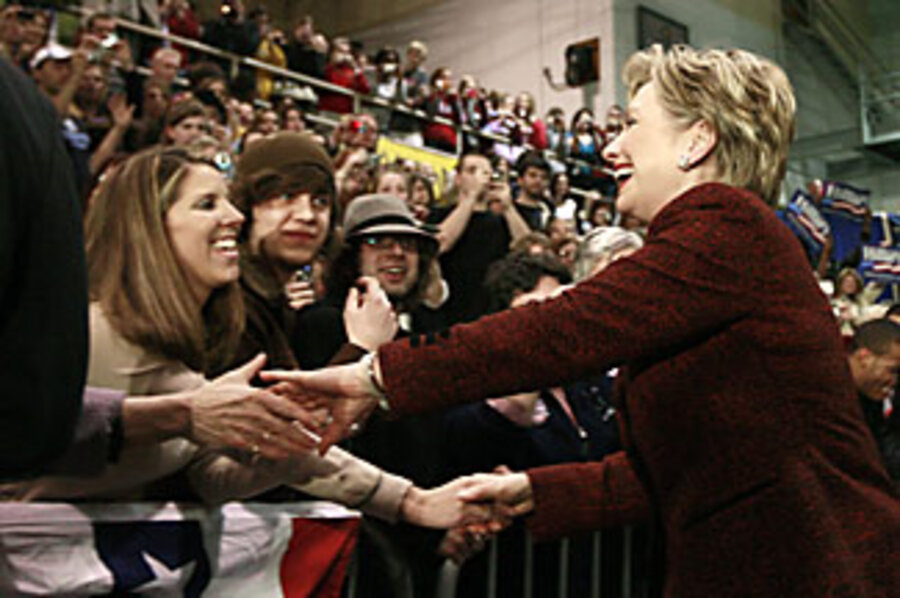'Other youth vote' is harder to mobilize
Loading...
| Philadelphia
Twenty-year-old Mike Santini, a diesel engine mechanic from Philadelphia, won't be voting in the state's April 22 primary. Like most young voters, the economy is a big concern for Mr. Santini – especially now that his hours at work are being cut – but he doesn't feel engaged enough to cast a ballot.
Even as young people have flocked to the polls this presidential primary season, one subset of the youth vote remains largely absentee: those ages 18 to 24 who, like Santini, have never been to college.
Here in Pennsylvania, where Sen. Hillary Rodham Clinton needs to beat Sen. Barack Obama decisively to keep her presidential hopes alive, turnout will be key – including that of this "other youth vote." When it comes to young voters, college students usually get most of the campaigns' attention, but here in Pennsylvania young people with no college experience slightly outnumber college students, data show.
That has both the Clinton and the Obama camps strategizing to reach the Keystone State's young noncollege voters. Efforts include sending text-message reminders about registration and poll dates (an approach found to boost voter participation by more than 4 percent, according to a 2006 study by the New Voters Project, a nonpartisan group working to engage young voters). The campaigns are also using social-networking platforms such as Facebook and MySpace and seeking out public spaces common to young people, regardless of their education levels, such as shopping malls and bars.
The Clinton campaign recently hosted concerts and events featuring celebrities to draw a diverse crowd, says Emily Hawkins, national youth outreach coordinator for Senator Clinton's campaign. On March 22, for instance, America Ferrera, star of ABC's "Ugly Betty," hosted a voter-registration rally for Clinton supporters at a downtown Philadelphia club.
So far this election season, young voters without college backgrounds have lagged behind their college-educated counterparts at the polls. On Feb. 5, the day of the Super Tuesday sweepstakes when 20-plus states held primaries or caucuses, 79 percent of young voters had some kind of higher education under their belts and 21 percent had a high school diploma or less, according to data compiled by the Center for Information and Research on Civic Learning and Engagement (CIRCLE).
The disparity is not a surprise, but "it's not good," says CIRCLE research associate Karlo Marcelo. This divide among young people is dangerous, he says, because it risks lessening the weight placed on issues important to young voters not in college.
"If they see that noncollege voters aren't going to come out and vote, the politicians aren't going to go out to them," says Mr. Marcelo.
The college-noncollege gap surfaced nationally in 1972, as unions and other organizations that had mobilized young people who didn't attend college declined. Reaching out to this group became expensive and time-consuming for campaigns, especially during the primaries.
College campuses have "built-in systems for mobilization," making them more appealing for large rallies or speeches by candidates, notes Chrissy Faessen, a spokeswoman for the voter mobilization group Rock the Vote.
Sara Press, an 18-year-old high school graduate who works at St. Mary's Hospital in Langhorne, Pa., says she plans to vote for Clinton in Tuesday's primary. The war in Iraq and the economy rank high on her list of issues, but Ms. Press says she doesn't feel connected to the campaigns. She has not been aware of any events and has learned about the candidates by doing Google-based research on her own.
"I know that if I was in college [the campaigns] would go to your dorms, but it's hard to get people who just live at home," says Press, who does live at home.
Registration data in the state shows that, as of April 13, people ages 18 to 24 made up about 10 percent of total registered voters. A CIRCLE report estimates that just over half of Pennsylvanians under 30 have no college experience.
Sean Smith, a spokesman for the Obama camp, says the campaign's youth outreach "is as inclusive as it can be, but by default a lot of organizing happens on campus." While the Obama campaign has not done targeted outreach to noncollege young people, Mr. Smith says, it believes campus-based networks can spread Obama's message to all young people.
Still, understanding the reasons for low turnout among noncollege youths is key to narrowing the voter-participation gap, says CIRCLE's Marcelo. A February 2008 CIRCLE report indicated that low-income young people tend to have less civics education than do higher-income peers. They are also less likely to attend college, an environment that provides students with even more opportunities for civic participation, such as political clubs and student government.
"High school is a place where people learn citizenship tools, learn how to interact with government, how to fill out a ballot,... and learn how to interact with the system," Marcelo says.
Without civic engagement among working young people and low-income individuals, he says, "those who need the most voice are left out."





